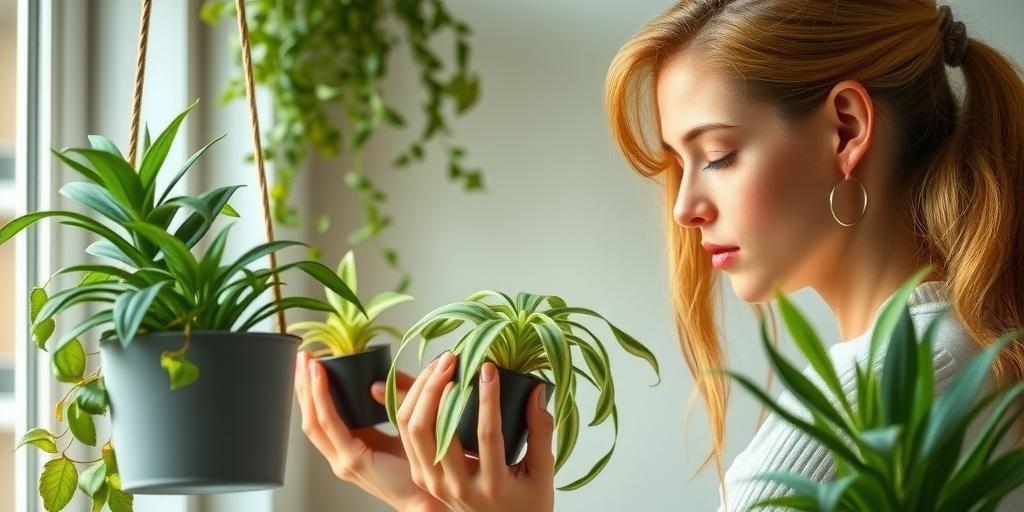
Essential Watering Tips for Low Light Hanging Plants: Keep Them Thriving
Discover essential watering tips for low light hanging plants to keep them healthy and thriving! Learn how often to water, signs of overwatering, and the best techniques for optimal growth.
Introduction
Did you know that overwatering is the #1 killer of indoor plants, especially those in low light? Hanging plants add beauty to any space, but without proper care, they can quickly wilt or develop root rot. Whether you’re a beginner or a seasoned plant parent, mastering the art of watering low light hanging plants is key to keeping them lush and vibrant. In this guide, we’ll share expert-approved tips to help your green friends thrive—even in the shadiest corners of your home!
Understanding Low Light Hanging Plants’ Watering Needs
Why Low Light Plants Need Different Watering Routines
Plants in low light conditions don’t photosynthesize as quickly as those in bright light, which means they use water at a slower rate. If you water them as often as sun-loving plants, you risk drowning their roots. Since they aren’t actively growing as fast, their soil stays moist longer, making them more prone to overwatering.
How Light Levels Affect Water Absorption
Light directly impacts how much water a plant absorbs. In brighter conditions, plants take up water more efficiently to support growth. But in dimmer spots, the soil takes longer to dry out. This means you’ll need to adjust your watering habits—waiting longer between sessions to prevent soggy soil, which can lead to root rot.
Common Mistakes to Avoid
-
Overwatering: The biggest killer of low light plants. Always check the soil before adding more water.
-
Underwatering: While less common, some forget that even slow-growing plants need hydration.
-
Poor Drainage: Pots without drainage holes trap excess water, suffocating roots. Always use containers with proper drainage.
How Often Should You Water Low Light Hanging Plants?
General Watering Frequency Guidelines
Most low light hanging plants do well with watering every 1-2 weeks, but this varies by species. For example, pothos and philodendrons can go longer between waterings than ferns or peace lilies. Always research your specific plant’s needs.
Factors That Influence Watering Schedules
-
Pot Size: Smaller pots dry out faster than larger ones.
-
Humidity: High humidity slows evaporation, meaning less frequent watering.
-
Season: Plants need more water in active growth seasons (spring/summer) and less in winter.
Best Practices for Checking Soil Moisture
-
Finger Test: Stick your finger 1-2 inches into the soil. If it’s dry, it’s time to water.
-
Moisture Meters: A handy tool for beginners to get precise readings without guesswork.
Signs Your Hanging Plant Needs Water (Or Has Too Much!)
Drooping or Yellowing Leaves: Underwatering vs. Overwatering
-
Underwatering: Leaves wilt, turn crispy, and the soil pulls away from the pot edges.
-
Overwatering: Yellow, mushy leaves and a persistently wet soil smell musty.
Root Rot Symptoms and How to Prevent It
Root rot happens when roots sit in water too long, turning brown and slimy. To prevent it:
-
Ensure pots have drainage holes.
-
Use well-draining soil.
-
Don’t let plants sit in standing water.
Crispy Edges vs. Mushy Stems—What They Mean
-
Crispy edges: Usually a sign of underwatering or low humidity.
-
Mushy stems: A red flag for overwatering or root rot.
Best Watering Techniques for Healthy Growth
Bottom Watering vs. Top Watering: Pros and Cons
-
Bottom Watering: Place the pot in a tray of water and let the soil soak it up. Great for preventing overwatering but can lead to salt buildup over time.
-
Top Watering: Pour water directly onto the soil until it drains out. More thorough but risks uneven saturation if done too quickly.
The Importance of Drainage Holes and Well-Aerated Soil
Without drainage, water pools at the bottom, drowning roots. Pair drainage holes with a chunky, airy soil mix (like peat with perlite) to keep roots happy.
Using Room-Temperature Water to Prevent Shock
Cold water can shock roots, especially in tropical plants. Always use lukewarm water to avoid stressing your plant.
Choosing the Right Soil and Pots for Optimal Moisture Control
Best Soil Mixes for Low Light Hanging Plants
-
Peat-based mixes: Retain moisture well but should be mixed with perlite for better drainage.
-
Orchid bark: Adds airflow, great for epiphytes like hoyas.
-
Perlite or vermiculite: Lightens soil, preventing compaction.
Ideal Pot Materials
-
Terracotta: Porous, helps soil dry faster—good for overwaterers.
-
Ceramic/Glazed: Retains moisture longer, ideal for thirsty plants.
-
Self-Watering Pots: Great for consistent moisture but require monitoring to avoid overwatering.
When and How to Repot for Better Water Retention
If water runs straight through the pot, the soil may be too compacted. Repot every 1-2 years with fresh, well-draining mix to maintain healthy roots.
Seasonal Adjustments for Year-Round Care
Watering Differences in Summer vs. Winter
-
Summer: Plants may need more frequent watering due to higher evaporation.
-
Winter: Growth slows—reduce watering to prevent soggy soil.
How Indoor Heating and AC Affect Humidity Levels
-
Heating: Dries out air quickly, increasing plant water needs.
-
AC: Can lower humidity, but cooler temps slow water use. Monitor soil closely.
Adjusting Care During Dormancy Periods
Many plants rest in winter, needing far less water. Let the soil dry out more between waterings and hold off on fertilizing until spring.
Conclusion
Watering low light hanging plants doesn’t have to be tricky—just follow these expert tips to keep them happy and healthy! Remember, the key is balance: not too much, not too little. Check the soil regularly, adjust for seasons, and choose the right potting mix to prevent common pitfalls. Ready to transform your hanging plants into lush, thriving beauties? Start implementing these tips today and watch them flourish!
